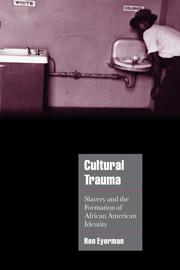Book contents
- Frontmatter
- Contents
- Acknowledgments
- 1 Cultural trauma and collective memory
- 2 Re-membering and forgetting
- 3 Out of Africa: the making of a collective identity
- 4 The Harlem Renaissance and the heritage of slavery
- 5 Memory and representation
- 6 Civil rights and black nationalism: the post-war generation
- Notes
- List of references
- Index
- Cambridge Cultural Social Studies
5 - Memory and representation
Published online by Cambridge University Press: 22 September 2009
- Frontmatter
- Contents
- Acknowledgments
- 1 Cultural trauma and collective memory
- 2 Re-membering and forgetting
- 3 Out of Africa: the making of a collective identity
- 4 The Harlem Renaissance and the heritage of slavery
- 5 Memory and representation
- 6 Civil rights and black nationalism: the post-war generation
- Notes
- List of references
- Index
- Cambridge Cultural Social Studies
Summary
I was theirs and they were mine. I sang the race memory, and we were united in centuries of belonging.
Maya AngelouThe historical context which set the parameters for a reworking of the discursive grounds for black American collective identity was bounded by the Great Depression and the Second World War. These events were significant in that they helped structure the formation of a generational awareness amongst black intellectuals, writers, and artists, and thus condition their attempts to reconfigure the process of identity-formation and collective memory. The new generation revisioned collective identity through a dialectic of remembering and forgetting within the process of cultural trauma begun earlier, and was structured by the two narrative frameworks set in place by the previous generation. Even as the younger generation struggled to define itself in opposition to the ideas and beliefs of their direct elders, they were bounded by inherited interpretative frames. The mass media, especially film and radio, would play a central role in the contemporary process of collective identity-formation, as would a range of social movements and their organizations.
The two artists mentioned at the end of Chapter 4, Aaron Douglas and Sargent Johnson, had something else in common other than their links to the Harlem Renaissance and a vision of the collective past. During the 1930s they benefited from the American government's active intervention to aid in the preservation and representation of American culture.
- Type
- Chapter
- Information
- Cultural TraumaSlavery and the Formation of African American Identity, pp. 130 - 173Publisher: Cambridge University PressPrint publication year: 2001

